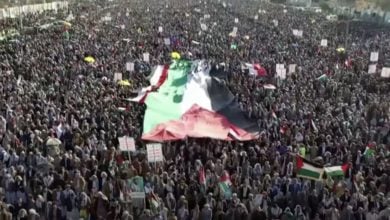Intense rain and winds from Mediterranean storm Daniel inundated eastern Libya this week, with exceptional damage hitting the low-lying coastal city of Derna. The death toll in this small city of 90,000 has already surpassed 10,000 with many others wounded or missing. Entire blocks and families have been washed into the Mediterranean.
While the world mourns this tragedy, it is crucial to remember that this is not simply a natural disaster. Blame for the unbelievable scale of the death and destruction lies at the feet of the Pentagon and its NATO allies, who destroyed the country’s central government in a 2011 war that plunged society into a state of chaos that continues to this day.
The storm, a so-called “medicane” – a Mediterranean tropical-like cyclone – brought winds of over 80 miles per hour, seven inches of rainfall, and waves up to 22 feet high following the rupture of two dams in the highlands to the south of Derna. The storm also caused massive flooding in Greece, Turkey, and Bulgaria – killing dozens – before increasing in intensity and hitting Libya. Storms like this are increasingly common in the Mediterranean as the average water temperature rises and is related to other extreme weather phenomena like the brutal heat waves and droughts that have become commonplace in southern Europe over the last several years.
The primary cause of damage and casualties was the failure of the two dams to the south of the city. Built in the mid-1970s by Yugoslav construction firm Hidrotehnika-Hidroenergetika, they have a collective capacity of about 20 million cubic meters of water. The dams have provided irrigation to surrounding areas and serviced the city with water for decades, an important piece of infrastructure for a region like this.
However, when the dams failed, over 30 million cubic meters of water were released into the city, washing away nearly a quarter of all buildings. The dams had not received major maintenance since the early 2000s and have been increasingly neglected since 2011. Additionally, the worsening climate crisis will require much more robust flood control infrastructure to be built and maintained.
These horrific scenes are being covered by western media with a cold detachment. For example, the Washington Post asks the question, “Why was the Libya flooding so deadly?” and provides answers replete with diagrams and aerial photography of the flooded city emphasizing “Rainfall,” “Geography,” and “Infrastructure.” The UN based World Meteorological Organization has stated that most casualties “could have been avoided” if Libya had “a normally operating meteorological service.”
But what is “not normal” about Libya? These same articles gesture towards “a decade of turmoil,” and “political deadlocks” and “divisions,” and allusions to the “difficult security situation.” It is true that climate change is at the root of this catastrophe. It is also true that the political institutions — or more accurately the lack thereof — exacerbated the deadly catastrophe in major ways, but the western media is obscuring the context and abrogating the responsibility of the NATO powers for the state of affairs in Libya.
Consequences of NATO’s war cascade into the present day
This is the image of Africa in general and Libya in particular that the western media cultivates —cursed to tragedy by geography and bad luck, mired in intractable violence and political instability, unable to solve its own problems or operate “normally.” In fact, prior to the 2011 NATO-backed coup d’etat that overthrew the Libyan government and long-time leader Muammar Gaddafi, Libyans enjoyed the highest standards of living on the African continent and shared in the profits from the natural resources of the country. Profits from gold and oil were put toward development goals, including infrastructure and social programs.
Since 2011 and the total collapse of the Libyan state, the country has been divided between various actors. In 2014, three years after the coup, Derna was taken by militants who pledged allegiance to ISIS. The city was the site of brutal fighting in between 2015 and 2018 when the ISIS-aligned militants were defeated by the forces of General Khalifa Haftar.
Haftar leads a militia called the Libyan National Army and currently controls large swaths of the country. He is based out of the eastern city of Tobruk and is supported by Russia and many regional Arab states. The United Nations recognizes the rival Tripoli-based Government of National Accord. Haftar, who was captured and held as a prisoner of war during the Chadian-Libyan war in the 1980s, was at the time a CIA asset who the Reagan administration hoped to use to foment a coup against Gaddafi. Upon release, Haftar spent the 1990s and early 2000s living in Langley, Virginia, where CIA headquarters is also based. But after the 2011 war, Haftar fell out of favor with his western backers.
The two rival governments are reporting different numbers for the missing and the dead from the flooding, coordinating with different international aid organizations for relief, and maintaining separate systems for mass communication and rapid response. This was also a major contributing factor in the lack of early warning for residents.
The destruction of the Libyan state in 2011 has had dramatic repercussions for the whole world — a key factor in the destabilization and proliferation of arms in the Sahel to the south. This in turn is intimately connected to the so-called “migrant crisis” that has shaped and molded European politics dramatically toward the right for the last decade.
Western media outlets superficially cover the flooding in Derna while absolving NATO and U.S. imperialism’s role in the political, historical, and economic context of this catastrophe and so many others playing out across the world.






